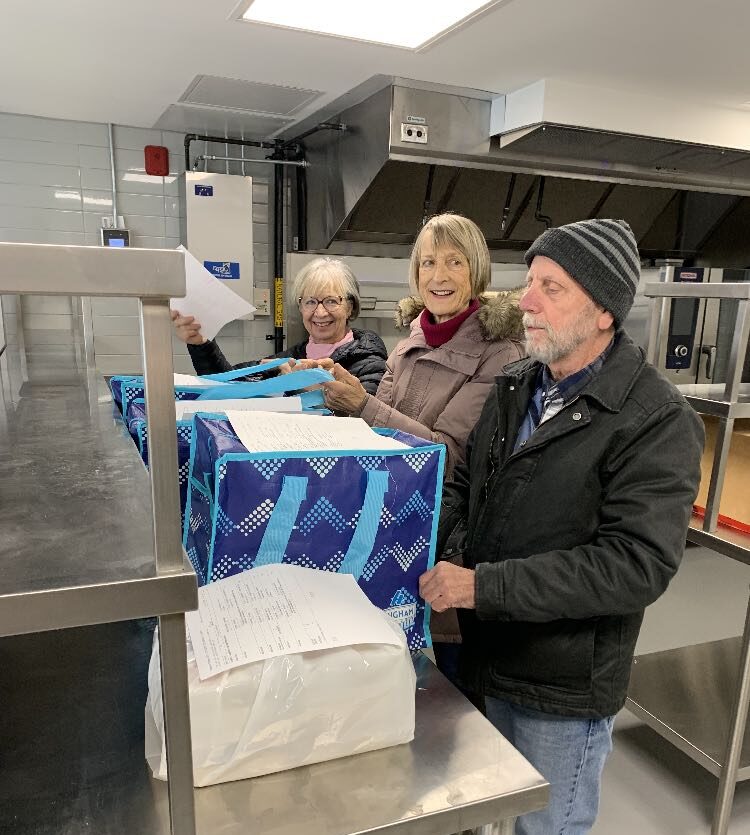A campaign to raise $500,000 to complete financing of Hollyer House, the affordable housing and community resource centre in Bells Corners, is in full swing.
“We are confident that we will reach our goal as parishes and individuals are moved to be part of addressing Ottawa’s critical shortage of safe, affordable homes for single folk and families in need,” the campaign’s co-chairs Sue Garvey and Cathy Seguin said in a statement.
Daniel Hussey, the campaign manager, said donations from parishes and individuals are part of a multi-pronged approach aimed at closing the gap. The other potential sources of support are suppliers to the project, the local business community and corporations.
Hussey is managing partner of Hussey Philanthropic Consulting, the firm that has guided the drive for $1.6 million, the Diocese’s contribution in partnership with Christ Church Bells Corners. The fund stands at about $1.1 million.
Garvey and Seguin have been visiting parishes to tell the Hollyer House story and gather support. “We sincerely appreciate the warm welcome and enthusiastic commitment we’ve received,” they said. Hussey adds: “We would like to thank all our individual donors, whose generous support has been fundamental to the success of our project.”
Applications have been made to corporations and foundations as part of the multi-pronged approach, he said. “All it takes is one to say yes and we’re on the cusp of our goal.”
Among those that have already said yes are the TD Bank Foundation, giving $100,000, Scotiabank giving $40,000 and the Anglican Foundation of Canada, contributing $15,000.
At an earlier stage of the project, the Hussey organization was able to land an anonymous donation of $250,000.
One part of the Hollyer story is already paying dividends. The FAMSAC Food Cupboard, providing emergency food aid to a wide area of west Ottawa and the Western Ottawa Community Resource Centre, offering a vast range of health and social services, are both in their spaces on the ground floor.
Trades are putting finishing touches to the residential areas. “We hope to have the building occupancy permit by the end of 2023,” the Rev. Canon PJ Hobbs, director general of Anglican Community Ministries said. “Barring any unforeseen circumstances, tenants will then be able to move-in sometime in the first quarter of 2024.”
The Hollyer experience can be seen as a clinic in developing a project through a pandemic. Commitments to proceed were made by the parish and the Diocese before the COVID-19 outbreak.The pandemic caused unforeseen shortages in supplies and labour, causing construction delays. Hopes for completion by last spring had to be moved ahead.
Campaign manager Hussey says that for fundraising, the pandemic served to raise the level of understanding about the importance of safe and affordable housing. This at a time when homelessness and the issue of affordable housing gained significant recognition in the public square.
He echoes the sentiments of Garvey and Seguin on the scale of need. “While the supply through this project isn’t going to solve the problem, this is an actionable project where you can make a difference, where you can add more to the supply of affordable housing. Every donation counts.”
The Hollyer apartments are open to everyone qualifying on the Ottawa Housing Registry, which has been an important fact for fundraising. “We had to assure [potential donors] that .. the conditions for benefitting are not religious in nature,” even though the project is led by a religious organization, Hussey says.
Both FAMSAC Food Cupboard and the Western Ottawa Community Resource Centre are already benefitting from having a permanent, purpose-built space.
Jeremy Leblanc, chair of the board of directors at FAMSAC, welcomes the stability after years of moving around multiple locations. He cites two significant benefits in addition to permanency.
Many customers face challenges other than food insecurity. The location makes it easier to refer them to services offered by the resource centre such as counselling, medical or language help. As well, Hollyer’s commercial kitchen, while primarily for the resource centre’s Meals on Wheels program, opens up the opportunity for FAMSAC to offer cooking and nutrition classes.
Leblanc acknowledges the significant benefit to FAMSAC of having some fit-up costs covered by the Diocese’s fundraising campaign.
For the Western Ottawa Community Resource Centre, the move to Hollyer opens a new chapter in a longstanding relationship with Christ Church Bells Corners and the Anglican Diocese of Ottawa.
The centre operated programs, including its Meals on Wheels service, out of the former rectory for many years. But preparation of the meals was contracted out commercially. The Hollyer kitchen gives the centre the opportunity to develop a new business model for the program, allowing it prepare the meals in-house and serve more people.
“It’s a big challenge for us,” executive director Leigh Couture says, “to see if we can lower costs.” The service provided 32,000 meals last year, up from 25,000 the previous year. Demand is expected to keep rising.
Couture agrees that the proximity to the FAMSAC Food Cupboard offers mutual benefits. “We can be aware of each other’s services and support people better.”
Similarly, residents of the 35 housing units will have onsite access to the outreach services offered by the resource centre.
Couture also expects to see benefits coming from Hollyer’s community room, a common space that is intended to serve both residents and the non-profit tenants. The centre will be able to use the space to offer programs and services that align with the interests and needs of the residents. Examples are a group program for folks who feel lonely, a diner’s club program and a health support group.


St. James, Morrisburg — Stormont Deanery